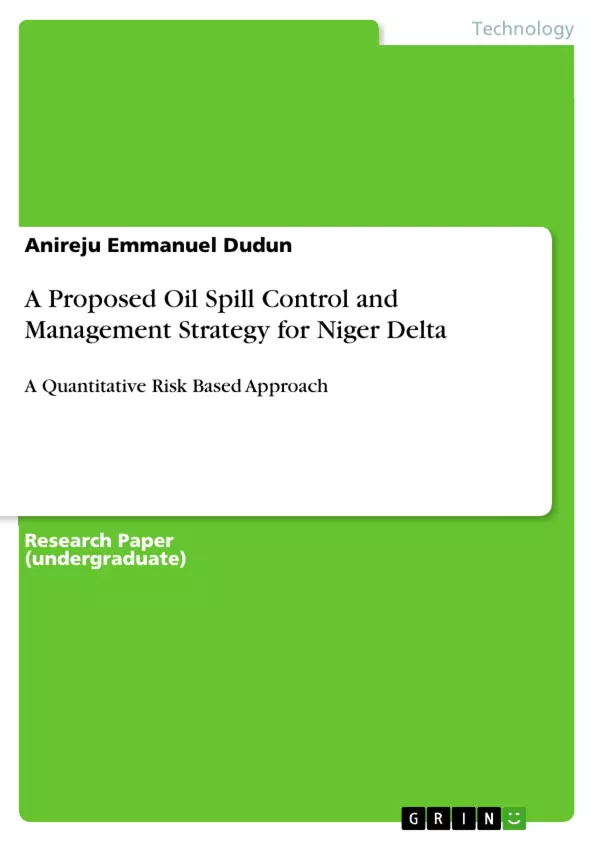Oil spill is one of the most dangerous side effects of crude oil exploration and production in the Niger Delta area of Nigeria. Its resultant effect on the environment, surface body of water, ground water, and biodiversity signifies that if appropriate measures of management are not put in place, the Niger delta’s coastal habitat and inland habitat will no longer be habitat able.
This paper examines the prevailing policies and procedure for the oil spill contingency planning in the Nigeria and identifies problems associated with the response action to oil spill incidents in the Niger Delta region. It also proffers solution to the problems, drawing on the wealth of experience gained from the oil spill preparedness and response put in place by some government agencies and operators across the globe. Based on this, the paper proposes a Quantitative risk based approach for the oil spill preparedness and response in the Niger Delta. This approach involves the quantification of risk as result of the probability of an event occurring and the impact potential of the event. Hence hazards and risks can be pre-determined and effective strategies could be developed to mitigate the impacts of potential oil spills.
Frequently asked questions
What is the main focus of "The Threat - Assessment of Spill Risk in Niger Delta"?
The text assesses the risk of oil spills in the Niger Delta, considering the region's environmental sensitivity and the concentration of petroleum activities. It outlines the infrastructure, including oil fields, pipelines, and terminals, and identifies potential causes of spills.
Where are petroleum activities concentrated in Nigeria, and why is this significant?
Petroleum activities are mainly concentrated in the Niger Delta, which is considered environmentally very sensitive to oil spills due to its complex ecological setting.
What infrastructure is mentioned in relation to oil transportation in the Niger Delta?
The text mentions 606 oil fields, 5,284 drilled oil wells, 7,000km of oil and gas pipelines, seven terminals (Bonny, Forcados, Qua Iboe, Escravos, Brass, Oloibiri, and Antan), and SBMs (Single Buoy Moorings) for loading crude oil onto vessels.
What are some of the primary causes of oil spillage identified in the text?
Causes include tank failure, tanker accidents, rupture of delivery lines due to ageing, oil well blowouts, sabotage, and cleaning of oil tankers on the high sea.
What is the National Oil Spill Contingency Plan (NOSCP)?
The NOSCP is a plan put in place by the government of Nigeria to curtail the problems associated with oil spills.
What is the general status of oil spill incidence in the Niger Delta?
Oil spills in the Niger Delta are a regular occurrence, resulting in environmental degradation and tension between local communities and oil companies. The rate of spill incidents is noted to be high.
What are some of the negative impacts of oil spills in the Niger Delta?
The negative impacts include environmental degradation, loss of agricultural land, psychological and social problems associated with displacement, massive corruption, unemployment, alleged neglect, and controversies regarding compensation.
What factors contribute to the rise of oil spill incidents in the Niger Delta?
The text points to ineffective technology, sabotage, and ageing facilities as contributing factors.
What are the shortcomings of current procedures for detecting oil spills and determining the extent of damage?
The procedures are described as cumbersome, semi-crude, and environmentally unfriendly. The text also mentions a lack of consensus on cleanup methods, ineffective cleanup and reaction times, and challenges in scientifically substantiating community claims regarding damage.
What are the problems associated with current procedures of the oil spill response?
Lack of consensus on cleanup and remediation steps, ineffective cleanup methods, unsubstantiated damage claims, lack of data about communities, no real-time detection of oil spills, time lapses before inspection and cleanup, mistrust among stakeholders, undocumented remediation, and no framework to predict spill locations.
What is a Quantitative Risk Assessment?
A Quantitative Risk Assessment provides data-based risk estimates derived using mathematical modelling and statistical analysis of data, quantifying risk as a result of the probability of an event occurring and the impact potential of the event.
What steps are suggested to improve oil spill management in the Niger Delta?
The text recommends a systematic approach involving compiling datasets on activity levels, establishing national datasets on blowout frequencies, compiling weathering characteristics for crude oil, undertaking oil drift simulations, developing a GIS interface, implementing national classifications of high environmental priority sites, and establishing regional oil spill response plans.
What role should the Clean Nigeria Association (C.N.A) play in oil spill management?
The C.N.A. should develop a risk-based approach for emergency preparedness, gather information on offshore activities, conduct event frequency studies and oil drift modeling and invest in heavy onshore and offshore response systems.
What is recommended to improve communication and data access related to oil spills?
There should be communication between industries and a dedicated Web site that helps to maintain communications with the General public.
What are the key conclusions and recommendations of the text?
The text emphasizes that relevant legislation should be based on the potential to pollute. Response planning must be proportional to its risk of pollution. Operators should be able to work with Governments to define their own risk profile and produce risk based control measures which aim to eliminate or reduce the hazards identified to an acceptable level. Data collection and sharing would greatly improve the efficiency of oil spill contingency planning.
- Quote paper
- Anireju Emmanuel Dudun (Author), 2012, A Proposed Oil Spill Control and Management Strategy for Niger Delta, Munich, GRIN Verlag, https://www.grin.com/document/388085



